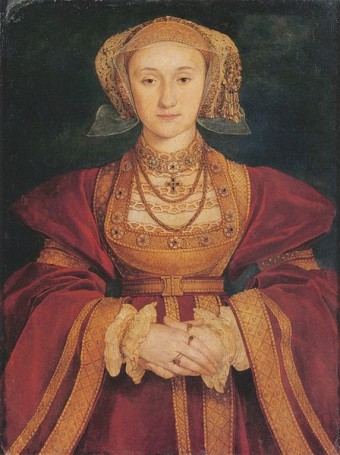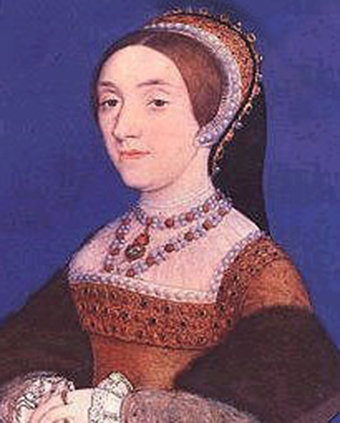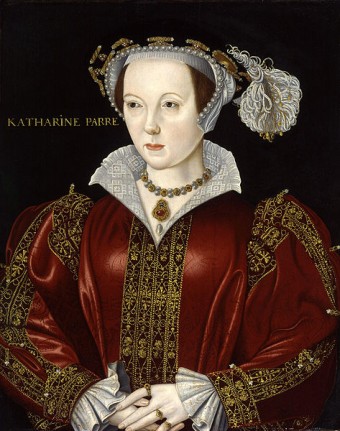The Wives of King Henry VIII, Part Two
 Today I found out about the last three wives of King Henry VIII: Anne of Cleves, Kathryn Howard, and Katherine Parr.
Today I found out about the last three wives of King Henry VIII: Anne of Cleves, Kathryn Howard, and Katherine Parr.
We last left off with King Henry finally receiving the heir to the throne he so badly wanted. However, Henry knew well enough that heirs could die, and after the death of his beloved wife Jane, he knew he needed to find another wife in order to make the “spare.”
Not to mention, Henry’s split from the Catholic church following his divorce from Catherine of Aragon and subsequent marriage to Anne Boleyn meant that England was largely isolated and vulnerable to the rest of the world. More than just a marriage for another son, he needed an alliance to boost England’s power once more.
The search for Henry’s new wife started shortly after Jane’s death, but Henry didn’t marry for another two years. It’s possible that he actually mourned Jane’s passing, or he was simply waiting on finding the perfect bride.
Wife #4: Anne of Cleves
Anne was born in Germany in 1515, making her 24 years Henry’s junior. Not a lot is known about her childhood except that she once had an engagement to the heir to a dukedom, which fell through.
Anne was considered a desirable match largely because Germany would be a formidable ally if Rome and France teamed up against England, as Henry feared they would. Her family was not tied to any specific religion, though her brother was a Lutheran, and so they were also at some risk if Rome and France went to war against countries that had defied the papacy.
 Henry sent an artist to paint portraits of Anne and her sister, Amalia, since he wanted to pick the prettiest one. Anne had been described as a “middling beauty” and her portrait must have been better than her sister’s. However, upon meeting his intended bride in England in 1539, Henry was less than impressed.
Henry sent an artist to paint portraits of Anne and her sister, Amalia, since he wanted to pick the prettiest one. Anne had been described as a “middling beauty” and her portrait must have been better than her sister’s. However, upon meeting his intended bride in England in 1539, Henry was less than impressed.
Anne spoke no English and so could not communicate effectively with her husband. She did not curtsy to him when she met him, as he had approached her party unannounced and she did not know who he was. She had had little education in anything other than domestic tasks, and so did not share Henry’s interest in music and literature. And on top of that, he did not think she was nearly as beautiful as reports claimed. Disgusted, Henry called her “the Mare of Flanders.”
Nevertheless, the treaty had already been drawn up, and the pair wed on January 6, 1540. It is unclear whether or not their marriage was ever consummated; after their wedding night, Henry denied that they had, saying, “I liked her before not well, and I like her now much worse.”
Due to Henry’s displeasure, it was a short marriage. He sent Anne away from court on June 24, 1540, and the marriage was annulled with Anne’s consent on July 9. There were no children from this marriage, but Anne was treated remarkably well after the annulment. Henry gave her several properties—including Hever Castle, which belonged to the Boleyns—and she was often invited back to court. After a while, she became known as “the King’s beloved sister” as she and Henry had become good friends. It’s likely all of this was done because she had not contested the annulment, and even gave evidence that their marriage had not been consummated.
That said, when it came to Henry choosing his sixth wife, remarrying Anne was put forward as an option—one he denied. Anne was said to be extremely jealous of Wife #6, Katherine Parr. Still, she ended up remaining close to the royal family, and even took part in Queen Mary I’s coronation. However, her close association with Princess Elizabeth caused her to fall out of favour in court, as officials believed she could have been plotting to see Elizabeth on the throne.
Anne died in July 1557 of cancer—one of two of King Henry’s wives to outlive him, and the last of his wives to die.
Wife #5: Catherine Howard (aka Kathryn Howard)
 Before his marriage to Anne of Cleves had been annulled, Henry had already become enamoured with young Catherine Howard. Catherine was born sometime between 1518 and 1527 and spent most of her childhood in the Dowager Duchess of Norfolk’s household. Interestingly, she was the first cousin of Anne Boleyn, the king’s second ill-fated wife.
Before his marriage to Anne of Cleves had been annulled, Henry had already become enamoured with young Catherine Howard. Catherine was born sometime between 1518 and 1527 and spent most of her childhood in the Dowager Duchess of Norfolk’s household. Interestingly, she was the first cousin of Anne Boleyn, the king’s second ill-fated wife.
During her time with the Dowager Duchess, Catherine is known to have had an “intimate” relationship with her music teacher from the time she was 13. Later, she fell in love with Francis Dereham, a secretary, and it’s very likely that the two intended to wed. They reportedly called each other “husband” and “wife” despite not being officially married, and Francis put Catherine in charge of his finances when he was away on other business—a wifely duty. The Dowager Duchess, however, put a stop to the relationship when she learned about it a year after it started.
Catherine arrived at court when she was about 19 years old to serve as a lady’s maid to Anne of Cleves (are you seeing a pattern yet?). Henry took notice of her almost immediately—she was young, pretty, giggly, and vivacious. Henry called her a “rose without thorns” and the “jewel of womanhood.”
The Howard family encouraged the burgeoning relationship, despite Henry pushing 50 at the time. They wanted more influence so that they could try to convert England back to Catholicism. Catherine—though likely not wholly attracted to the old, overweight king with an ulcerous leg—had little choice in the matter.
The two were married just 16 days after the marriage to Anne of Cleves was annulled. Catherine is said to have lifted the king’s spirits for a time, but she herself was not entirely happy with the arrangement. She started a series of affairs which would eventually catch up with her.
First, she is thought to have had a relationship with Thomas Culpeper, Henry’s favourite courtier. Their secret meetings were arranged by Anne Boleyn’s brother’s widow, who had her own reasons to defy the king. Then, she appointed Frances Dereham as her personal secretary—likely more went on behind closed doors than simple secretarial duties.
However, her previous relationship with Dereham was known by most of the staff at her childhood home, and Anne began receiving requests for favours in exchange for their silence. Ultimately, she was caught and thrown in prison.
She could have been saved if she’d simply admitted to a “precontract” with Dereham—basically, a pre-marital contract that would have seen them married in the eyes of the church. If she had agreed that there was one, her marriage with Henry would have been annulled and she could not have been convicted of adultery. As it was, she claimed that Dereham raped her. With evidence from servants in the Dowager Duchess’ household, and testimony from her old “intimate” music teacher, no one believed her.
Thomas Culpeper and Francis Dereham were executed in December 1541. Catherine was beheaded on February 13, 1542.
Wife #6: Katherine Parr
 An interesting thing to note about the final wife of King Henry VIII is that she was named after the first. Katherine Parr’s mother was Maud Green, who served as a lady’s maid to Catherine of Aragon. Katherine Parr was born in 1512, and was raised to be a rather independent woman for her time. Her mother was left widowed when Katherine was just five years old, and ended up managing her late husband’s estates herself.
An interesting thing to note about the final wife of King Henry VIII is that she was named after the first. Katherine Parr’s mother was Maud Green, who served as a lady’s maid to Catherine of Aragon. Katherine Parr was born in 1512, and was raised to be a rather independent woman for her time. Her mother was left widowed when Katherine was just five years old, and ended up managing her late husband’s estates herself.
As for Katherine, she and Henry were well-matched; she’d had a string of marriages before she married the king as well. Her first husband was Edward Borough, who died after just a few years of marriage. Her second was John Neville, who had two children from a previous marriage. She and the rest of his family were held hostage during the Pilgrimage of Grace rebellion, but John managed to secure their release. He died in 1543.
Afterwards, Katherine was employed in Princess Mary’s household, where she came to the attention of both King Henry and Thomas Seymour, the late Jane Seymour’s brother. She expressed an interest in Thomas and likely wished to marry him, but the king would not give his consent and asked for her hand instead. It was not a lady’s place to say no to the king, especially not a man who had beheaded two of his wives and countless others.
So, Katherine married Henry on July 12, 1543. She is known for helping Henry reconcile with his two daughters, who he had previously disowned. In addition, she developed a good relationship with Henry’s son and had a hand in Elizabeth’s education.
She was also, despite being raised Catholic, a supporter of the Protestant reformation. She had a surprising amount of control over the king, something that worried the conservatives in Henry’s court and was almost her undoing. They caught wind of the fact that she had banned books in her rooms, a treasonous offense, but they were unable to produce evidence. Katherine played up to Henry’s ego and was forgiven.
Henry died in 1547, leaving his throne to nine-year-old Edward. Katherine probably thought she would have some part in the regency, but she made the mistake of marrying Thomas Seymour shortly after Henry’s death in a secret ceremony, and people were scandalized thinking that the relationship had gone on while Henry was still alive. Instead of taking control of Edward’s reign, she was given guardianship of Princess Elizabeth and Lady Jane Grey, the king’s cousin.
It wasn’t until 1548, aged 36, that Katherine became pregnant for the first time. She gave birth to a daughter, Mary, in August. She died a week later from complications with the birth.
If you liked this article, you might also enjoy our new popular podcast, The BrainFood Show (iTunes, Spotify, Google Play Music, Feed), as well as:
- The Wives of King Henry VIII, Part One
- King Richard the Lionheart of England Lived Mainly in France and Barely Spoke English
- Sleeping Beauty is Based on a Story Where a Married King Finds a Girl Asleep and Can’t Wake Her, So Rapes Her Instead
- The Bluetooth Standard is Named After a 10th Century Scandinavian King
- The Modern King Leonidas: Athanasios Diakos
| Share the Knowledge! |
|





I can forgive the egregious editing, but not incorrect years.
“However, upon meeting his intended bride in England in 1939, Henry was less than impressed.” — He met her in 1539.
“Katherine Parr was born in 1542” — she was born in 1512
@John: Good catch. I can tell you no professional author I’ve ever worked with has been able to not make that exact mistake all the time. For some reason our fingers are all primed to always type “19XY.” Even being aware of the issue, I myself often miss the mistake when editing (and make the typo in my own writing). Given the prominence of the problem, I’ve often wondered if perhaps the most recent generation coming up, when they reach the work force, will have a similar problem- if they’ll end up always typing “20XY” for every date, or if because it starts with a “2” instead of a “1” that will break the cycle. On the second one, I’d guess it was just because she just typed 1542 a couple sentences before in the death of the other Catherine. 🙂